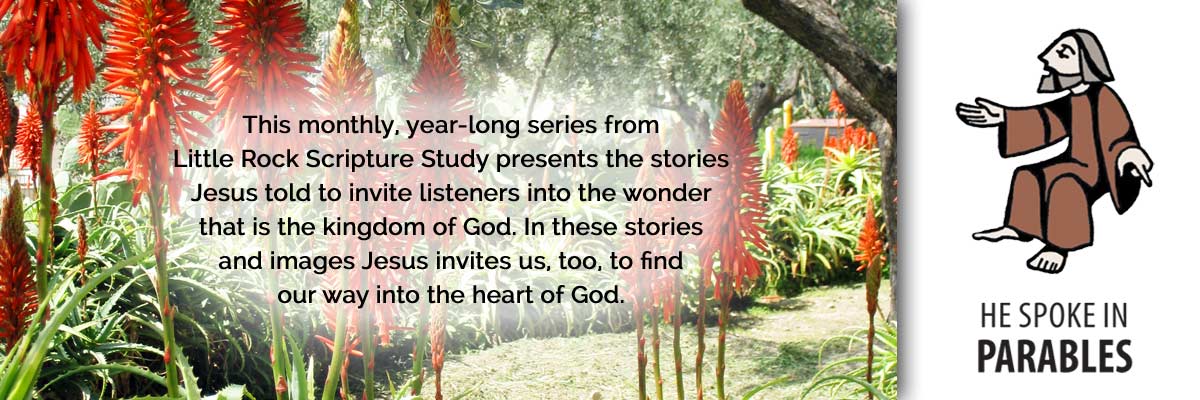Official Website of the
Catholic Diocese of Little Rock
Follow Jesus by serving others
Published: December 5, 2015
This is the 12th column in a 12-part series.
By Cackie Upchurch
Director of Little Rock Scripture Study
Effective teachers know the value of repetition, literally repeating core teachings so they will be caught and remembered, and crafting what they teach in a way that will echo in the minds of their students. Jesus, the Master Teacher of Matthew’s Gospel, makes use of repetition too, hoping that his followers allow his words and deeds to echo in their hearts.
 The final judgment scene in Matthew 25:31-46 makes use of the metaphor of sheep and goats. And the wording of this section reinforces the importance of what we have come to call the corporal (or tangible) works of mercy — feeding the hungry, giving drink to the thirsty, welcoming strangers, clothing the naked, caring for the sick and visiting those in prison.
The final judgment scene in Matthew 25:31-46 makes use of the metaphor of sheep and goats. And the wording of this section reinforces the importance of what we have come to call the corporal (or tangible) works of mercy — feeding the hungry, giving drink to the thirsty, welcoming strangers, clothing the naked, caring for the sick and visiting those in prison.
All of these phrases are repeated four times in 16 verses. Surely we are meant to realize the importance of these activities as people of faith.
The works of mercy serve as markers of righteousness in the lives of those who will inherit eternal life. The list is not meant to be exhaustive for surely there are additional ways that our faith is called into action. But note that in all cases the common thread is providing for persons who are in need, whatever the circumstance and without judgment.
In fact, these works of mercy appear in a scene that illustrates that Jesus has the ultimate authority to judge between the sheep and the goats, the “blessed” and the “accursed.”
It is not the job of Jesus’ followers to pass such judgment on others; rather, Jesus’ followers are forcefully reminded that taking action on behalf of the dispossessed, or failing to take action, has consequences.
In Matthew’s Gospel this scene occurs in a discourse, or collection of teachings, described as apocalyptic (chapters 24 and 25). The followers of Jesus are confused and pondering his predictions of the destruction of the temple in
Borrowing imagery from the Old Testament book of Daniel, the judgment scene in Matthew 25 opens with a description of the Son of Man coming in glory with his angels, and “all the nations” assembled before him. Scripture scholars have offered a variety of informed opinions about the identity of these nations.
Do “the least of these” represent of any group of people in need, any variety of backgrounds? If so, then the lesson is intended to throw a wide net when attending to those suffering in the world. Or, given how Matthew has used such language previously in his Gospel, is “the least of these” a reference to Jesus’ Jewish disciples? If that is the case, then the parable might be directed to the Gentiles, challenging their treatment of Jesus’ followers. In this latter interpretation, the judgment is rendered on a community that has failed to extend care to those outside of their community.
In both scenarios, righteousness is proactive. It is about responding to need, not simply about right thinking but about right acting. It is about being in right relationship with others and with God and living in a way that demonstrates this mutual relationship.
What is profound in this scene is that those who are being judged seem not to realize that their treatment of others is, in fact, treatment of Jesus himself. They might admit that they did or did not act mercifully or generously to others, but their questions show that they have not equated love of neighbor with love of God, the two pillars that Jesus held up as the greatest command (Matthew 22:34-40).
As we close this series of articles focused on Jesus’ parables, and enter the Holy Year of Mercy, how appropriate that we allow ourselves to be disturbed by this image of sheep and goats. As a teacher, Jesus was not concerned simply with handing on information, but with handing on a way of living that reflects the profound transformation that disciples will experience as they grow in union with him.
Jesus intended to confront and startle his followers, not simply to throw them (and us) off balance, but to issue an invitation to citizenship in a kingdom that will transform our world.
Study Questions
- Are you encouraged or are you discouraged by this famous judgment scene of Jesus separating the sheep from the goats (Matthew 25:31-46)? Why? How can your reading of this passage become life-giving for you?
- When you consider your faith community, how do you see the corporal works of mercy being embraced? Is such activity front and center as an expression of your parish’s life?
- What will you do in the coming weeks to look for opportunities to serve the needs of others?
- How have the parables of Jesus invited you to think differently? To act differently?
This article was originally published in Arkansas Catholic Dec. 5, 2015. Copyright Diocese of Little Rock. All rights reserved. This article may be copied or redistributed with acknowledgement and permission of the publisher.




